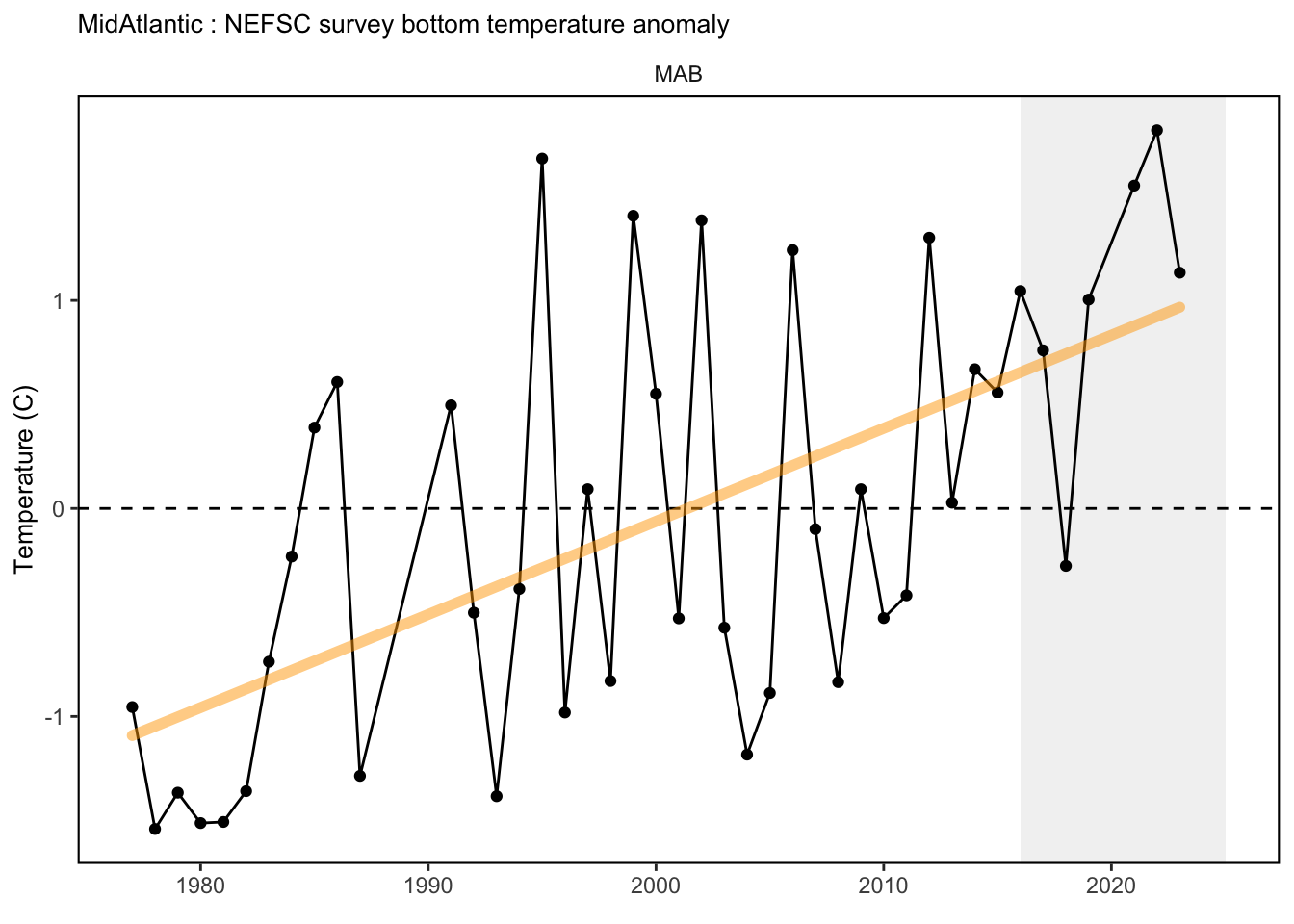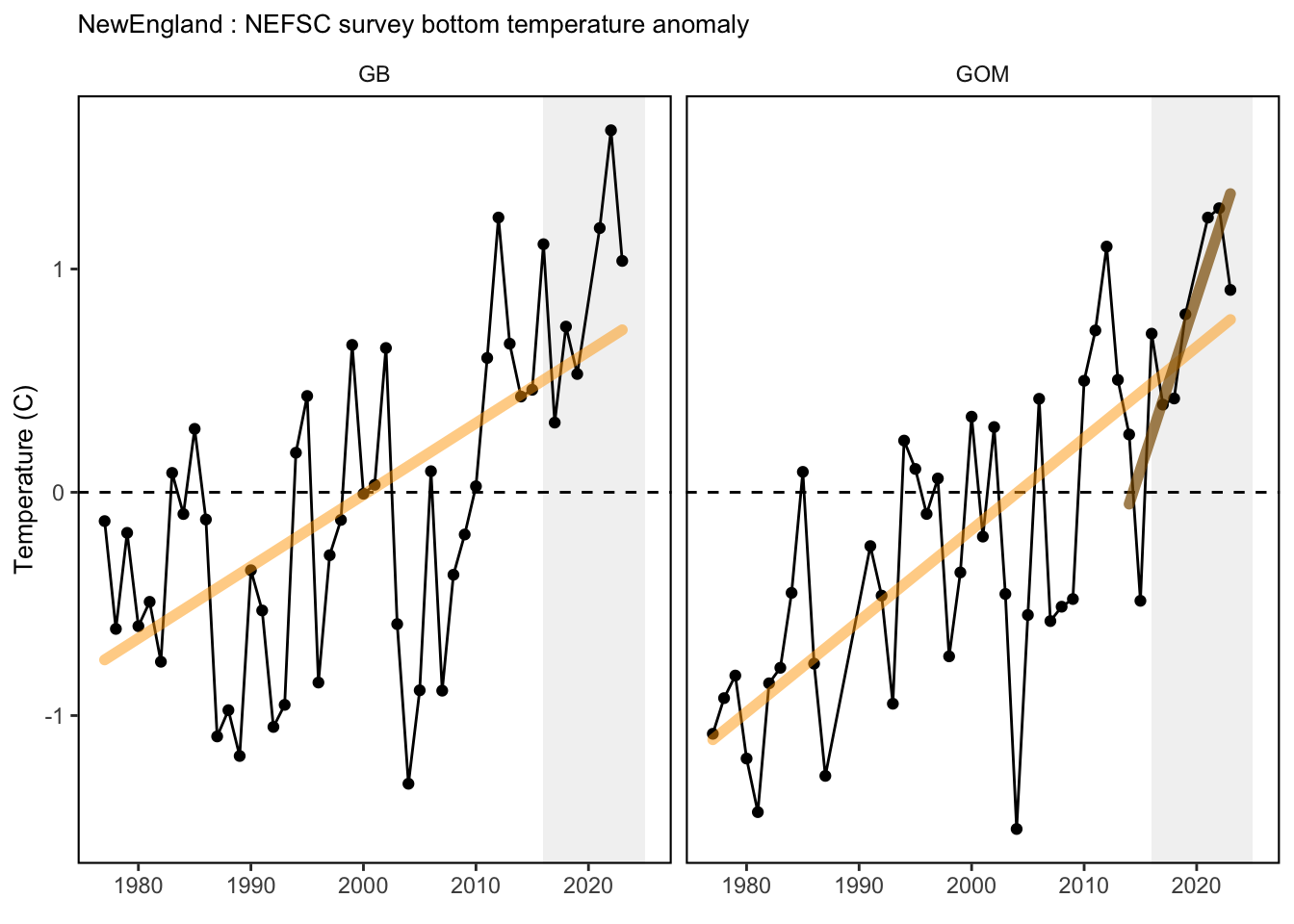SMART Indicator Report: Bottom Temperature - in situ
2 Indicator name
Bottom Temperature - in situ
Includes variable(s): bottom temp anomaly in situ, reference bt in situ (1981-2010), reference sst in situ (1981-2010), sst anomaly in situ
3 Indicator brief description
The data presented here are time series of regional average bottom temperature anomalies from ship-based measurements made on the Northeast Continental Shelf.
5 Indicator documentation
5.1 Are indicators available for others to use (data downloadable)?
## Yes5.1.1 Where can indicators be found?
## Data: https://noaa-edab.github.io/ecodata/index.html
## Description: https://noaa-edab.github.io/catalog/bottom_temp_insitu.html
## Technical documentation: https://noaa-edab.github.io/tech-doc/bottom_temp_insitu.html5.1.2 How often are they updated? Are future updates likely?
[need sequential look at datasets for update frequency. Future requires judgement]
5.2 Gather indicator statistics
5.2.2 Length of time series, start and end date, periodicity
General overview: Annual
Indicator specifics:
Indicator | EPU | StartYear | EndYear | NumYears | MissingYears |
|---|---|---|---|---|---|
bottom temp anomaly in situ | GB | 1977 | 2023 | 46 | 1 |
bottom temp anomaly in situ | GOM | 1977 | 2023 | 43 | 4 |
bottom temp anomaly in situ | MAB | 1977 | 2023 | 43 | 4 |
bottom temp anomaly in situ | SS | 1977 | 2023 | 41 | 6 |
reference bt in situ (1981-2010) | GB | 1977 | 2023 | 46 | 1 |
reference bt in situ (1981-2010) | GOM | 1977 | 2023 | 43 | 4 |
reference bt in situ (1981-2010) | MAB | 1977 | 2023 | 43 | 4 |
reference bt in situ (1981-2010) | SS | 1977 | 2023 | 41 | 6 |
reference sst in situ (1981-2010) | GB | 1977 | 2023 | 46 | 1 |
reference sst in situ (1981-2010) | GOM | 1977 | 2023 | 43 | 4 |
reference sst in situ (1981-2010) | MAB | 1977 | 2023 | 43 | 4 |
reference sst in situ (1981-2010) | SS | 1977 | 2023 | 43 | 4 |
sst anomaly in situ | GB | 1977 | 2023 | 46 | 1 |
sst anomaly in situ | GOM | 1977 | 2023 | 43 | 4 |
sst anomaly in situ | MAB | 1977 | 2023 | 43 | 4 |
sst anomaly in situ | SS | 1977 | 2023 | 43 | 4 |
5.2.3 Spatial location, scale and extent
General overview: by EPU
Indicator specifics:
Indicator | EPU |
|---|---|
bottom temp anomaly in situ | GB |
bottom temp anomaly in situ | GOM |
bottom temp anomaly in situ | MAB |
bottom temp anomaly in situ | SS |
reference bt in situ (1981-2010) | GB |
reference bt in situ (1981-2010) | GOM |
reference bt in situ (1981-2010) | MAB |
reference bt in situ (1981-2010) | SS |
reference sst in situ (1981-2010) | GB |
reference sst in situ (1981-2010) | GOM |
reference sst in situ (1981-2010) | MAB |
reference sst in situ (1981-2010) | SS |
sst anomaly in situ | GB |
sst anomaly in situ | GOM |
sst anomaly in situ | MAB |
sst anomaly in situ | SS |
5.3 Are methods clearly documented to obtain source data and calculate indicators?
## Yes5.3.1 Can the indicator be calculated from current documentation?
[Build link to Tech-doc, look for current and previous methods]
5.4 Are indicator underlying source data linked or easy to find?
[Build link to Tech-doc, look for source, may require judgements]
5.4.1 Where are source data stored?
[Build link to Tech-doc, look for source, may require judgement]
6 Indicator analysis/testing or history of use
6.1 What decision or advice processes are the indicators currently used in?
The bottom temperature index incorporates near-bottom temperature measurements collected on Northeast Fisheries Science Center (NEFSC) surveys between 1977-present. Early measurements were made using surface bucket samples, mechanical bathythermographs and expendable bathythermograph probes, but by 1991 the CTD – an acronym for conductivity temperature and depth – became standard equipment on all NEFSC surveys. Near-bottom refers to the deepest observation at each station that falls within 10 m of the reported water depth. Observations encompass the entire continental shelf area extending from Cape Hatteras, NC to Nova Scotia, Canada, inclusive of the Gulf of Maine and Georges Bank.
6.3 Do target, limit, or threshold values already exist for the indicator?
[Fill by hand; if not in key results or implications, likely does not exist]
6.4 Have the indicators been tested to ensure they respond proportionally to a change in the underlying process?
[Fill by hand; if not in introduction, key results, or implications, likely not tested]


7 Comments
[Fill below by hand once above data complete]
7.1 Additional potential links to management in addition to uses listed above
7.2 What additional work would be needed for the Council to use the indicator?
7.3 What issues are caused if there is a gap or delay in data underlying the indicator